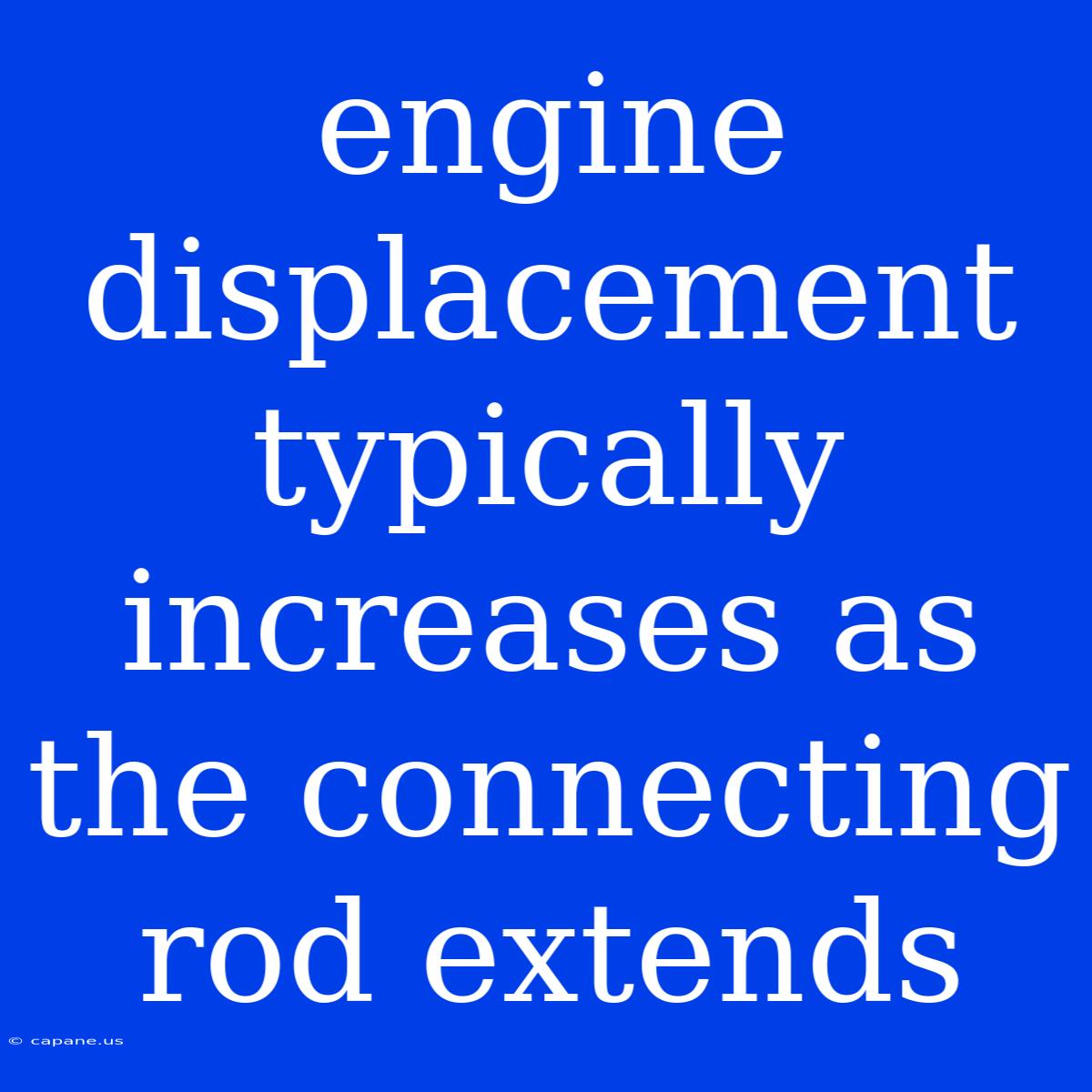Does a Longer Connecting Rod Mean More Engine Displacement?
Is engine displacement directly tied to connecting rod length? A common misconception is that longer connecting rods automatically translate to greater engine displacement. While connecting rods play a vital role in engine performance, their length doesn't directly influence engine displacement. Let's explore this relationship and understand the true connection between these two engine components.
Editor Note: This article clarifies the relationship between connecting rod length and engine displacement, debunking common misconceptions and providing a deeper understanding of internal combustion engine mechanics.
Understanding the Importance: Disentangling the connection between connecting rod length and engine displacement is crucial for anyone involved in automotive design, tuning, or performance modifications. Comprehending this relationship helps to make informed decisions about engine upgrades and optimization.
Analysis: We've delved into various sources, including technical manuals, engine design articles, and expert discussions to offer an in-depth analysis. This article consolidates the key takeaways from our research, providing a clear picture of the complex interplay between engine components.
Key Takeaways:
| Feature | Explanation |
|---|---|
| Engine Displacement | Total volume of air an engine can intake and combust. |
| Connecting Rod Length | The distance between the crankshaft journal and the piston pin. |
| Direct Influence | Length does not directly impact displacement, as displacement is determined by bore and stroke. |
| Indirect Impact | Rod length influences engine's efficiency, torque characteristics, and overall performance. |
Connecting Rod Length and Engine Performance
Connecting rod length significantly affects engine performance, though not through displacement. Here's how:
Connecting Rod Length
- Introduction: Connecting rods serve as the mechanical link between the piston and the crankshaft, transforming linear piston motion into rotary crankshaft motion.
- Facets:
- Role: Transferring force from the piston to the crankshaft during combustion.
- Examples: Longer rods are commonly found in high-performance engines, while shorter rods are typically found in smaller, more compact engines.
- Risks & Mitigations: Longer rods might introduce increased stress on engine components. Proper design and material selection mitigate these risks.
- Impacts & Implications: Longer rods can influence factors like:
- Increased stroke: Longer rods allow for a longer stroke, potentially increasing displacement.
- Improved combustion chamber shape: Optimizes combustion and improves efficiency.
- Reduced piston speed: Minimizes wear and tear on the engine components.
Summary: While not directly affecting displacement, connecting rod length plays a crucial role in engine performance by influencing factors like stroke length, combustion efficiency, and piston speed.
Engine Displacement
- Introduction: Engine displacement refers to the total volume swept by the pistons during one complete revolution of the crankshaft.
- Facets:
- Role: Determines the engine's power output and torque characteristics.
- Examples: A larger displacement engine typically produces more power and torque, while a smaller displacement engine tends to be more fuel-efficient.
- Risks & Mitigations: Larger displacement engines might require more fuel and generate higher emissions.
- Impacts & Implications: Engine displacement directly impacts several aspects:
- Fuel Consumption: Higher displacement leads to increased fuel consumption.
- Emissions: Larger engines often produce more emissions.
- Performance: Higher displacement typically results in greater power and torque.
Summary: Engine displacement is determined by the bore and stroke, not directly by the connecting rod length. It's a fundamental factor that defines an engine's power output and fuel consumption characteristics.
FAQ
Introduction: This section addresses common questions about the relationship between connecting rod length and engine displacement.
Questions & Answers:
- Q: How does connecting rod length impact engine performance?
- A: Longer connecting rods generally lead to a smoother power delivery, improved combustion efficiency, and reduced piston speed, thus enhancing overall engine performance.
- Q: Can I change the connecting rod length to increase engine displacement?
- A: No. Connecting rod length does not influence engine displacement, which is determined by bore and stroke.
- Q: What are the advantages of longer connecting rods?
- A: Longer rods can offer improved performance, increased stroke potential, and a more efficient combustion process.
- Q: What are the disadvantages of longer connecting rods?
- A: They might increase stress on engine components and require careful consideration during the design and manufacturing process.
- Q: What are some factors to consider when choosing connecting rod length?
- A: Target performance, engine design constraints, and budget.
- Q: How can I optimize engine performance without changing displacement?
- A: Through modifications like camshaft upgrades, exhaust tuning, and engine management system optimization.
Summary: While connecting rod length doesn't influence displacement, it plays a significant role in engine performance, impacting factors like stroke length, piston speed, and combustion efficiency.
Tips for Understanding Connecting Rod Length
Introduction: This section provides insights into how to understand the significance of connecting rod length.
Tips:
- Research engine specs: Familiarize yourself with the stock connecting rod length and its relationship to the engine's overall design.
- Consult with experts: Seek guidance from automotive engineers or experienced mechanics for accurate advice on connecting rod modifications.
- Consider material selection: Connecting rod material plays a crucial role in their strength and durability.
- Focus on balanced performance: Engine modifications should strive for a balanced improvement in performance while maintaining reliability.
- Prioritize professional installation: Ensure that any modifications, particularly those related to connecting rods, are professionally installed to maintain engine integrity.
Summary: Understanding connecting rod length and its impact on engine performance is crucial for optimizing engine potential while maintaining reliability.
Engine Displacement and Performance: A Comprehensive View
Conclusion: While connecting rod length doesn't directly affect engine displacement, its impact on engine performance is undeniable. Longer rods can contribute to improved power delivery, combustion efficiency, and reduced piston speed.
Closing Message: For those interested in tuning or modifying engines, a deep understanding of the relationship between connecting rod length and engine performance is essential. By carefully considering these factors, you can optimize your engine for maximum performance and reliability.

